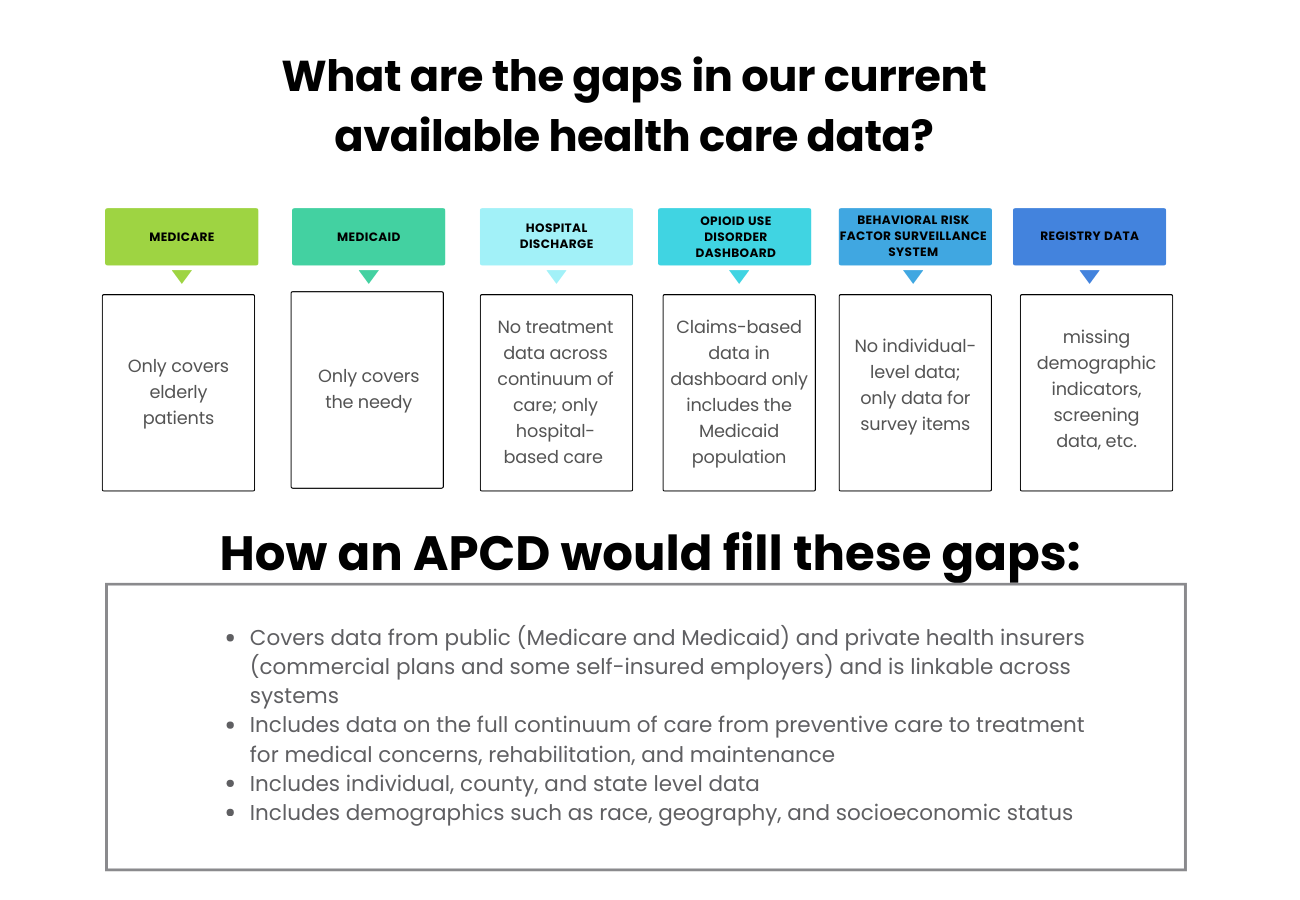
Why Kentucky needs an
All-Payer Claims Database (APCD)
An All-Payer Claims Database (APCD) is a data aggregation tool that provides a wholistic picture into where and how health care dollars are spent. APCDs collect transactional data — including services rendered, as well as the amount paid — from public (Medicare and Medicaid) and private health insurers (commercial plans and some self-insured employers). APCDs convert disparate data from each of these sources and across the continuum of care into one comprehensive, standardized data set.
Who benefits from an APCD and how?
-
Insights from an APCD will enable research and data-driven policies that can lead to higher quality of care for Kentuckians. The cost-transparency element of an APCD will cut down on unnecessary expenses for care that increase out-of-pocket costs for consumers.
-
An APCD can help providers and hospitals better understand patient populations, identify trends, and make more informed decisions about care delivery. By providing comprehensive data on health care utilization and costs, an APCD can help health systems operate more efficiently, provide higher-quality care, and ultimately improve the health and well-being of their patients and communities.
-
An APCD would give state and local policymakers the full picture of the complex landscape of health care spending. By showing where the costs are coming from and where the burden is falling – an APCD can inform research and policies that save money, increase access to care, and improve health outcomes.
-
An APCD would allow employers to see the full impact of various health insurance plans- from costs to quality of care. This would assist with benefit design and planning, allowing employers to improve health outcomes while more effectively managing their healthcare expenses. It would also aid in implementing and complying with new federal fiduciary and transparency rules that require employers to pay a “fair price” for health benefits.
-
Establishing an APCD in Kentucky would provide insurance companies with a number of benefits, including: comprehensive cost analyses; a means for identifying fraudulent activities; improved care coordination and overall quality improvement; and pricing and risk assessment.
An APCD is a win for Kentuckians.
It will lead to a higher quality of care and better health in Kentucky, while also identifying ways dollars can be used more efficiently… thus reducing unnecessary expenses for care that increase out-of-pocket costs for consumers.
How APCDs are helping other states
APCD Myth Busters
Myth number 1: We don’t need an APCD, we already have all the data available from other sources
We do have access to some data, but not in an integrated system where data is linked to provide population level analysis.
Myth number 2: APCDs are a partisan issue
APCDs have been enacted in both blue and red states. See examples above.
Myth number 3: APCDs are used to regulate and cap commercial prices
APCD do not have the authority to regulate or cap prices. Some states (Montana, Oregon, and Washington) do cap prices, but those programs were enacted by state legislatures, not APCDs. APCDs only provide data and information that can inform policymakers.
Myth number 4: APCDs violate patient privacy and put patient data at risk of a data breach
APCDs comply with Health Information Portability and Accountability Act (HIPAA) and HITECH act, National Institute of Standards and Technology (NIST), and other federal and state regulations. Data is encrypted, and submissions are sent over encrypted connections. Personal Identifiers are removed and replaced with encrypted identifiers not linked to any other source. Other identifying information is aggregated such as age, zip codes, small cell data suppression.
-
-Understand health care costs and utilization trends among treatment settings, providers, and modalities
-Inform state health care planning and targeted population health initiatives
-Support research in the areas of health care cost, quality, and accessibility
-Evaluate the effectiveness of health care programs and services to improve patient outcomes
-Improve the accessibility, adequacy, and affordability of health care through the review and dissemination of data
-
-Require all state-regulated payers to participate with an opt-in for self-insured and ERISA-governed plans
-Define the information that will be collected, identify permitted uses and general reporting requirements
-
-Designate a qualified party to implement, operate, and maintain the APCD
-Establish rule-making authority associated with the development of the APCD
-Create an APCD Advisory Council consisting of stakeholders, including consumers, hospitals, insurers, researchers, etc.
-Establish a uniform file format and data use agreements
-
Comply with Health Information Portability and Accountability Act (HIPAA) and HITECH act, National Institute of Standards and Technology (NIST), and other federal and state regulations
-
Create a sustainable funding model based primarily on federal funding, grants, donations, and user fees
Key elements of APCD legislation
Hear from the experts!

Data Protection
APCDs have strict safeguards and regulations in place to protect patient privacy. The data is usually anonymized before being made available for analysis, ensuring confidentiality while still allowing for valuable insights.
Kentucky Cabinet for Health and Family Services
Foundation for a Healthy Kentucky
Insights4Health
Kentuckiana Health Collaborative- employer members
Kentucky Department of Insurance
Kentucky Equal Justice Center
Kentucky Voices for Health












